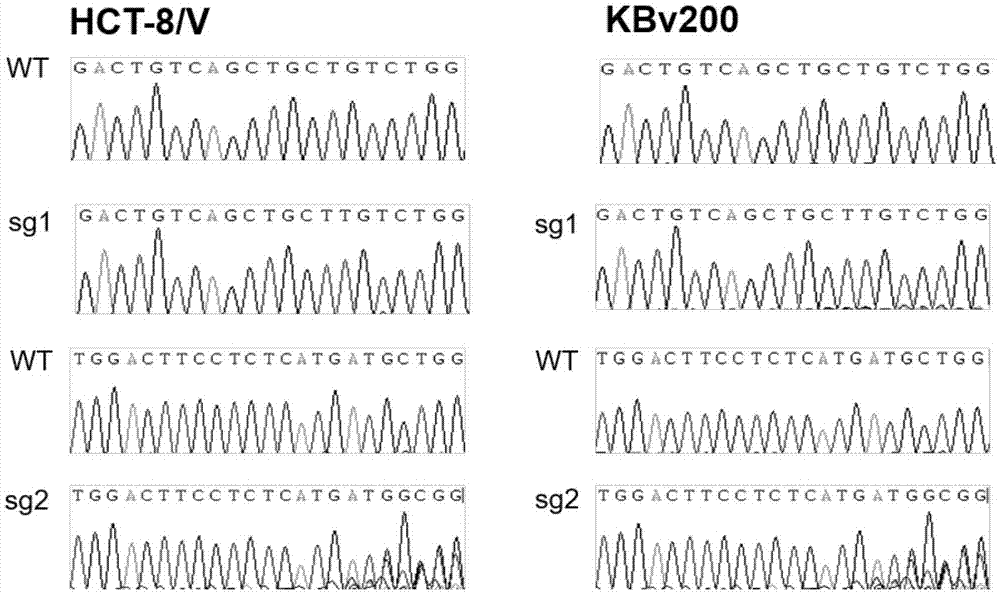sgRNA targeting sequence of specific target human ABCB1 gene and application
A kind of specific and genetic technology, applied in sgRNA guide sequences and application fields, to achieve the effect of solving the problem of multi-drug resistance
- Summary
- Abstract
- Description
- Claims
- Application Information
AI Technical Summary
Problems solved by technology
Method used
Image
Examples
Embodiment 1
[0037] (1) sgRNA design
[0038] According to the genome sequence of human ABCB1 gene (geneID:5343), two sgRNAs targeting human ABCB1 gene were designed. The 20nt oligonucleotide sgRNA guide sequence is: Sg1: 5'-TTGGACTGTCAGCTGCTGTC-3' (located in the eighth exon of gene ABCB1) and Sg2: 5'-GACTGTCAGCTGCTGTCGTC-3' (located in the fifth exon of gene ABCB1 exon)( figure 1 ); add CACCG to its 5' end to obtain a forward oligonucleotide (Forwardoligo); obtain its corresponding DNA complementary strand according to the guide sequence, and add AAAC to its 5' end to obtain a reverse oligonucleotide (Reverseoligo ). Synthesize the above-mentioned forward oligonucleotides and reverse oligonucleotides respectively, denature the Forwardoligo and Reverseoligo of the synthesized sgRNA oligonucleotides in pairs, and anneal; after annealing, a double strand connected to the expression vector lentiCRISPRv2 vector can be formed, At the same time, the designed gRNA target sequence was blasted ...
Embodiment 2
[0046] (1) Co-transfection of core plasmid and packaging plasmid pMD2.G and psPAX2 into 293T cells
[0047] Cultivate 293T cells until the confluence rate of 293T cells reaches 50% to 60%, 12 to 18 hours after seeding is the best time for transfection; replace fresh culture medium before transfection, add 3mL medium to a 60mm dish; The amount used is 4 μg of core plasmid (lentiCRISPRv2-hABCB1-Sg1 or lentiCRISPRv2-hABCB1-Sg2 prepared in Example 1, and lentiCRISPRv2 empty vector as a control), psPAX23 μg, pMD2.G1 μg, PEI 24 μL, supplemented with DMEM to a total volume of 200 μL , the order of addition is DMEM, PEI and plasmid DNA (core plasmid, pMD2.G and psPAX2); then stand at room temperature for 30 minutes to fully polymerize PEI and plasmid DNA, and add the transfection system dropwise to the above-mentioned cultured 293T cells after the polymerization In a small dish, shake gently and place in 37°C 5% CO 2 Continue culturing in the incubator;
[0048] (2) Virus harvest an...
Embodiment 3
[0061] Example 3 In vitro cell experiments to identify the knockout effect of the human gene ABCB1 on the cells after screening
[0062] (1) western blot
[0063] The p-gp protein expression levels of the cell lines HCT-8 / Vsg1, HCT-8 / Vsg2, KBV200sg1 and KBV200sg2 successfully knocked out of the ABCB1 gene in Example 2 were identified by westernblot experiments, and the cell line HCT- 8 / V and KBv200 were used as controls, in which the primary antibody was Anti-ABCB1 (MMSC-13131, purchased from santacruze), the secondary antibody was Anti-mouseIgG, HRP-linkedAntibody (Product No. 7076, cellsignaling), and the specific method was the conventional westernblot operation process .
[0064] The result is as Figure 4 As shown, in HCT-8 / V and KBv200 cells, there is a significant difference in the expression of p-gp between the cells transfected with sg1 and sg2 and the cells only transfected with the vector, and p-gp protein is almost not expressed in sg1 and sg2, which can be As o...
PUM
 Login to View More
Login to View More Abstract
Description
Claims
Application Information
 Login to View More
Login to View More - R&D
- Intellectual Property
- Life Sciences
- Materials
- Tech Scout
- Unparalleled Data Quality
- Higher Quality Content
- 60% Fewer Hallucinations
Browse by: Latest US Patents, China's latest patents, Technical Efficacy Thesaurus, Application Domain, Technology Topic, Popular Technical Reports.
© 2025 PatSnap. All rights reserved.Legal|Privacy policy|Modern Slavery Act Transparency Statement|Sitemap|About US| Contact US: help@patsnap.com



